Dateline: 7 August 2006
Many people who visit this blog know what a chicken tractor is, and some even have one or more of them. For those who don’t know, a chicken tractor is a moveable cage for chickens. The cage has a top and sides but no bottom—it sets directly on the ground and is moved every day to a fresh patch of grass. The idea behind a chicken tractor is that the birds can supplement their grain ration with fresh greens and bugs and worms and stones for their gizzards. They also get plenty of fresh air and sunshine. Birds raised in a chicken tractor get all the good things that industrial chickens—those raised by the millions in factory farms—do not get. As a result, the quality of a harvested factory bird pales in comparison to that of a properly raised chicken-tractor bird.
I built myself a chicken tractor eight years ago and I have used it to raise birds for my family every season since then. Two years ago, I built a second tractor. Based on my experience and observations, I believe the perfect chicken tractor should meet several key requirements. It should be inexpensive and easy to build by someone with basic handyman tools and skills. It should be strong and durable, yet lightweight and easy to move by hand, but not so light that a gust of wind blows it away. Furthermore, the perfect chicken tractor should be varmint proof, provide shade and protection from the rain and, at the same time, be well ventilated. Finally, the perfect chicken tractor design should allow the chicken farmer (that’s you) to easily feed and water the critters.
There are all kinds of homemade chicken tractors out there. Some are better than others but, as far as I’ve been able to determine, all have their shortcomings. In other words, the perfect chicken tractor has yet to be built. Nevertheless, you don’t need a perfect chicken tractor to raise your own wholesome, tasty birds. Which brings me to my own chicken tractors....
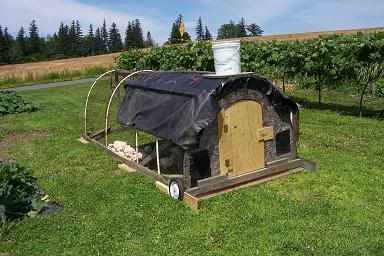
The photo above is of the chicken tractor I made eight years ago. It measures five-feet by 12-feet. The bottom frame is pressure treated 2x4 fastened together at the corners with 3” drywall screws. 2x4 angle braces on each corner (visible in an upcoming photo) keep the frame square and make it strong.
The five hoops are 3/4” PVC pipe, available from any hardware store. Poultry netting covers the whole thing, except for the one end which is waferboard. After eight seasons (outside for 12 months of the year), and several repairs, the waferboard door was finally no good and we replaced it this season with another of 1/2” CDX plywood. I also reinforced the waferboard in other ways as needed to get it through another season.
The tarp on the top is a heavy duty one I salvaged from my town’s junk days. The ends of the tarp have a 2x4 on them. Stiff wire bent into hooks hangs from the top of the tractor and slips into screw eyes in the 2x4 to hold it up, as shown here in these photos. When unhooked, the weight of the 2x4 attached to the tarp holds it down and helps seal along the bottom edge.
I put the tarp sides down at night when slinking varmints are typically on the prowl. And I fill in any gaps around the bottom perimeter with scrap pieces of 2x4 and plywood, as shown in the following photos. I also leave my dog, Annie, outside to help deter night predators.
The pail on top gravity feeds water down through a hose to a Plasson bell waterer, which is visible in the next picture.
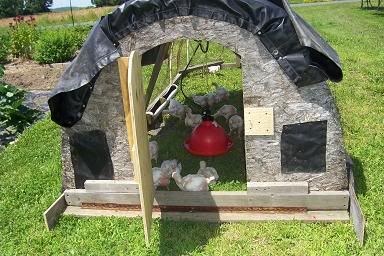
In the photo above you can see the hose coming down from the bucket to the waterer which is suspended from the top of the tractor with a length of wire. So the waterer rides right along with the tractor when it is moved and I can adjust the height of the rim to accommodate the chickens as they grow.
The 10” wheels on the one end of the tractor were purchased at Home Depot. They are simply bolted to the 2x4 bottom with 1/2” bolts. At first, the tractor had no wheels. I moved it by pulling a rope attached to the other end and it was a tough pull. There is no way that my kids or my wife could move it in a controlled manner. The addition of those two wheels made the tractor incredibly easy to pull around. Even with the bucket of water full (around 30 pounds) my wife can now movethe tractor.
If you’ve never had a chicken tractor you might think that moving it would be no problem if you hook on to it with a small tractor (the motorized kind). Well, you certainly can move it easily with such a tractor but you’ll also probably run over the birds. That’s because they are not the smartest of creatures and some will not get along like you want them to. That being the case, you want to move the chicken tractor with some finesse, and that means by hand.
The only problem with the wheels on the one end is that they elevate the frame off the ground a bit. The space provides an entry point for small varmints. But the varmints are typically a night problem and between the 2x4 tarp ends and a few scrap blocks of wood, any spaces can be easily sealed for the night.
As you look inside the open door in the photo, you’ll see a feeder along the one side. That feeder is nothing more than a section of inexpensive plastic drain pipe. I cut a slot down the length and screwed round wood plugs in the ends. Then I screwed the length into the side of the tractor. it moves along with the frame. I can fill the trough feeders (on each side) from outside by pouring feed from a scoop through the wire.
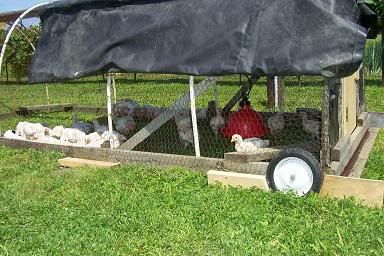
Here’s another view of the tractor. You can see the wheel, the bottom frame, and the Plasson waterer. If you observe closely, you will see two angled braces. They extend from each side of the bottom frame up to the top of the door end of the tractor. These braces are made of lightweight pine furring strips and they provide considerable rigidity to the entire unit.
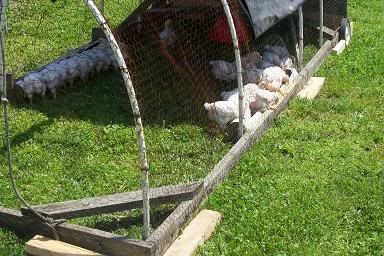
The photo above clearly shows the 2x4 angle brace in the bottom corner. The chicks are lined up at the feeders. The pull rope is visible in the left of the picture. This photo also shows the chicken wire (a.k.a., poultry netting) held to the hoops with pieces of twisted wire.
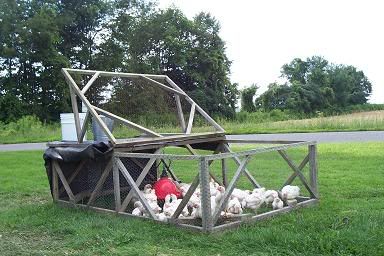
The above photo is another chicken tractor variation that I made two years ago. It is akin to the tractors used by joel Salatin but it is much smaller. The tractor measures five-feet by eight-feet and is 28-inches high. The frame is made of 1-1/2” by 1-1/2” pressure treated wood. It has the same watering system and the same kind of tarp, permanently attached in the back, with 2x4 weighted drop-down sides. The top opens (as shown in the photo) for easy access. I have a feeder that I put in and take out when I want to move the tractor. This tractor has no wheels and a pull rope on both ends
In the final analysis, my Salatin style chicken tractor with the big door on top looks really nice and it’s built incredibly solid but the thing is way too heavy to move by hand. The other drawback is that it is not very big. Maximum full-grown chicken capacity is around 25 birds.
My hoop tractor, as homely as it appears, is a better tractor to work with. In fact, when I look at my previously stated criteria for the perfect chicken tractor, my eight-year-old hoop unit comes close. The only real drawback is the feeder troughs. They need to be longer and I think I could come up with a little better design for them. Capacity for the hoop tractor is 35 to 40 birds, which is good enough for a small producer like me.
One of these years, I’ll build another version of chicken tractor. It will be different from the hoop tractor I already have, but not much different.
==========
Speaking of chickens, here are links to some other blog essays that you may find interesting and useful:
Talkin' Bout My Chicken Tractor (Part 2)
Backyard Poultry Processing With My 11-year-Old Son
My Whizbang Plucker Story
Frequently Asked Questions About The Whizbang Plucker
Introducing My Deluxe Homemade Chicken Scalder
The Next Best Thing To A Whizbang Chicken Plucker
How To Butcher A Chicken
My Chicken Plucker Parts Business
FREE Chicken Feed
Turkeys in Tractors & Comfrey For Feed
























































































































23 comments:
We too have evolved with our chicken tractors. Our first one was a Joel Salatin type pen. It lasted for many years, in fact we gave it away and it may still be in use. Then we tried that style of pen out of PVC. I think we must have used the wrong type of PVC as it barely lasted the first year. Oh, but was it easy to pull. Then when we moved on this farm, we built a style very similar to yours that is like a hoop house, although ours had pointed roofs. I believe there are pictures of our pens at http://www.amazinggrazefarm.com/poultry.html. We also have one that is rounded on the top like yours. We need to add wheels though as they are so heavy to pull. On one of the pens, we cut a large PVC pipe in half so that it was like 2 troughs. We put one of these on the front and back cross bar on the foundation. This made is slide much easier.
Very informative! We were introduced to chicken tractors last year and have tweaked our design each time. The most important features for us are:
1. ease of movement
2. ease of getting to the food & water
Herrick
I too started with a Salatin style tractor. Found it way too heavy and it was small (5x5). I then found something similar to yours, but decided to use wire panels instead of pvc for the hoop. One thing I found to improve the ease of movement was screwing lengths of PVC pipe (cheap drain pipe)on the front, back and sides. It will amaze you how easy it is to move. You don't have to cover the whole length either as I used one ten foot section of 4 inch pipe to do all 4 sides. I saw this somewhere so it wasn't my idea but it works so well I thought I would pass it along.
By the way love my whizbang plucker. It's AWESOME!!!
Daymond
Georgia
This is very helpful. Thank you for sharing.
This was very helpful to me also! great pictures too.
I considered using chicken tractors for my muscovy ducks and my geese but I think movable electric net poultry fencing provides them with a better home. The net has 3 inch squares that prevent predators from entering. It's 48 inches high and so far nothing has jumped it. I use movable chainlink dog kennel panels inside the electric net for their night pens. I've had no predation or escapes. My goats use it too.
The nets allow the animals to run, flap their wings and interact with each other. Putting 2, 164 foot long nets together allows me to leave them in one spot for several days. I try to rotate the net around the kennel like a wheel around an axel. I do pull the kennel over a few feet to keep the birds on clean ground. A tarp on top of the kennel provides shade and rain shelter.
As I'm not very big and I farm alone, the nets are easy for me to move - the posts are sewn right into it. I can also thread a net through my wooded areas to give the goats browse and encourage the birds to eat weeds like garlic mustard.
The nets also provide me a wonderful place to sit and watch my livestock enjoying life, splashing in their kiddy pool, sunning themselves, racing around and behaving as God meant them to behave.
Kim
The Salatin style tractor works well in my experience, but you have to build them light enough. The 5x5 you describe has as much lumber in it as Joel's 10x12 as he uses 3/4" thick lumber for the vast majority of it. A major part of the rigidity of their tractors comes from the aluminum roofing skin covering it. In strategic places i.e. corner uprights and the horizontal roof diagonal that the waterer sits on are made from 2x2's (actual dimensions 1.5x1.5). But, realize it will still be a bit floppy which is good for those of us who have somewhat uneven ground as they are somewhat ground conforming.
Another key is that the salatin tractors are moved with a homebuilt wheel dolly and have a pull "cord." These are used by dragging the pen while you walk backwards facing the chicks. Don't try to move these pens without wheels, though maybe the pvc pipe half skids would help.
Joel uses the same waterers and uses old large chicken feeders that you can remove from the pen while moving them.
Some drawbacks:
Hard to move to a new farm as they are really hard to get into most moving trucks intact and are awfully wide to drive down the road on a trailer.
Read Joel's book on how to corral the chickens so you can get them out to slaughter, it is tricky.
I have had the solid access hatch blow away a few times but did not lose birds but realize I lived in a windmill farm area on a similar height/exposure hill. It is also helpful to make the "lids" bigger in all directions than the space they enclose as the pen will distort in the field with use and it is annoying to have to resort to sticks and such to keep the lids on.
I may try some of the hoop designs next time, but maybe not. I'm 6'6" and maneuvering inside that maybe no better than in joel's 2' high pen when I can take the roof off half of it.
Hope this helps.
Mark
When you want to raise many thousands of birds you need big pens and something that lends itself to mass production and assembly line servicing techniques.
In Joel's case, one person takes out the feeders and moves the pens another person or two fills the waterers from a stock tank (also moved with the pens) and a barrel with 300-to 2000lbs of feed in it (also moved with the birds, but typically only 1x/wk).
Understand he's working at a scale that
Any chance you'd consider putting a "subscribe by email" widget on your blog for folks like me who never remember to keep up with other people's blogs without getting notification of new entries?
I found you while I was looking for info on varmint proof chicken tractors. Lo and behold, we have a mutual blogcquaintance, Granny Miller.
Hi there,
I just killed and butchered my first batch of roosters (usually left to someone else, but I have finally plucked (intentional pun)the courage to do so myself) with the help of four of my home-educated children the other day, and was just checking to see that we had done the butchering bit "correctly". We did a few things differently, but the basics are the same... it was really good to see the great clear photos and descriptions of the step-by-step process!
I was intrigued by the pictures of your chooks with their heads still attached.... I couldn't work out how on earth you had despatched them, as we did it with an axe and a chopping block, and ended up with a bloody mess, not those "rubber chickens" look-alikes that you had!
Then I saw the killing cones... what a nifty idea! And the plucker... I must confess to enjoying the plucking, and we only scalded the birds when we couldn't easily remove any more feathers (when we got to the wings and tails), but then we only did half a dozen, I imagine that it could get a bit wearing to have to pluck more than that...
However the point of this comment was why do you use tractors?
Why not have a chook pen to lock them in at night, with roosts? Then they can wander free-range to their heart's content, drinking from the stock troughs or buckets and eating all of the slugs and snails and grasshoppers and beetles and the maggots (in the remains of the roos you butchered last week in the compost heap), as well as giving you great joy when they all come running to you when they hear that call "chooooook, chooook, choook", knowing that you have got a bucket of grain for them to eat?
Is it because you have so many more predators in the US than we have here Downunder?
Or is it a garden protection scheme? I must admit that chook er,FEMAT is not the most pleasant of things to be walking in and transfering onto the carpet...
By the way, we collected the birds we wished to kill from their perches in the evening, (no stress or flapping around)and placed them in a small cage for the next day's events.
herrick,
i designed a chicken tractor using EMT. it is lightweight and easy to move check it out. i am enjoying your plucker book and can offer you no higher praise than it is well worth the money.
I am surprised how many people know of/use the Salatin design for chicken pens. I bought one and tried to make one; they were way too heavy and the wheels were too small. One thing I found, was these cheap tarp garages. For $200 CDN I got a 20ft by 10ft pen, 8ft high, completely covered and strong enough to hang a feeder from the center. I hated the 2' high pens that I had to crawl around in to catch birds.
The problem with these is the tarps didn't last long in the sun and the wind would push them around.
We did 200 birds last year and I'm looking for ways to increase the efficiency of our butchering.
Anyways, I've really enjoyed what I've enjoyed what I've seen of your blog so far.
From Alberta, Canada. Take care.
We're on our fourth generation chicken tractor. Like you, we are constantly working toward lighter tractors --- in the end, I think weight is the most important factor in tractor design.
The other important thing we learned is that it's essential to use an automatic chicken waterer. It's way too easy for a traditional waterer to tip on uneven terrain and drain dry, as we learned to our chagrin when two birds died of heat stroke.
I just made a chicken tractor like this for use this year and I love it! I did add wheels to the back and it's quite easy to move. I wanted to share what I've done with the feeder trays. In particular I wanted to be able to leave the feeders inside the coop and yet not have to get inside the coop to fill them up. Click on the link below for my blog which has a full description and a video of me filling the feeders! Enjoy!
Here is the link:
http://lakesregion.wcsh6.com/news/home-garden/73208-filling-meat-bird-feeder-tubechute
Thanks for the informative post! What did you attach the pvc ribs to the wooden frame with? Did you use conduit straps or something else?
Thanks!
Cody
Thanks for sharing the information about your chicken tractors. Good to know your thoughts on the two different styles. I was thinking about a hoop-type house for next season.
What length pvc poles are bent for use? I have built heavy duty tractors for my laying hens which allows them to roost. But I'd like to make a model like yours for meat birds - lighter and less$. All the eggs and meat go to non-profit local food bank as we're a church - get this - with 65 acres!
Thanks - Pat McLaughlin
Pat,
I'm surprised I didn't put the length in the article. They are 10' long.
Any issues with predators digging under?
How did you attach the pvc pipes to the 2 x 4 base?
Kyle,
I put a screw through a pre-drilled hole near the end of the pvc hoops, into the 2x4 near the bottom. Then, near the top of the 2x4, I used a galvanized pipe strap for that size pipe. Two screws to hold the clamp. Simple and totally sufficient.
Best wishes,
Herrick Kimball
Unknown,
No issues with predators, except once. After that, if there is any unevenness in the ground, creating a small opening, I block it with a scrap of wood. No problems since then. Also, the chicken tractors are in my yard, near my house, and I have a dog. They are not out in a field.
Thank you so much for sharing all this wonderful information.
large tarpaulin sheets
Post a Comment